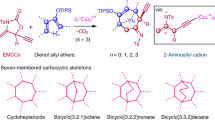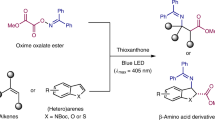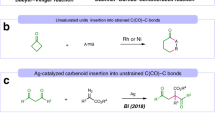Abstract
Per(6-O-tert-butyldimethylsilyl)-α-, β- and γ-cyclodextrin derivatives are well-known as synthetic intermediates that enable the selective mono-, partial, or perfunctionalization of the secondary face of the macrocycles. Although silylation of the primary rim is readily achieved by treatment with tert-butyldimethylsilyl chloride in the presence of pyridine (either alone or mixed with a co-solvent), the reaction typically results in a mixture containing both under- and oversilylated byproducts that are difficult to remove. To address this challenge in preparing a pure product in high yield, we describe an approach that centers on the addition of a controlled excess of silylating agent to avoid the presence of undersilylated species, followed by the removal of oversilylated species by column chromatography elution with carefully designed solvent mixtures. This methodology works well for 6-, 7-, and 8-member rings (α-, β-, and γ-cyclodextrins, respectively) and has enabled us to repeatedly prepare up to ⁓35 g of ≥98% pure product (as determined by HPLC) in 3 d. We also provide procedures for lower-scale reactions, as well as an example of how the β-cyclodextrin derivative can be used for functionalization of the secondary face of the molecule.
This is a preview of subscription content, access via your institution
Access options
Access Nature and 54 other Nature Portfolio journals
Get Nature+, our best-value online-access subscription
$29.99 / 30 days
cancel any time
Subscribe to this journal
Receive 12 print issues and online access
$259.00 per year
only $21.58 per issue
Buy this article
- Purchase on Springer Link
- Instant access to full article PDF
Prices may be subject to local taxes which are calculated during checkout







Similar content being viewed by others
Data availability
All new data within the protocol are described in the main text and, especially, in the Supplementary Information. We have uploaded data to ChemSpider:
Hexakis(6-O-tert-butyldimethylsilyl)-α-cyclodextrin: http://www.chemspider.com/Chemical-Structure.22906192.html?rid=1005ca4c-3af0-424e-9d66-ce62c6fbd2af
Heptakis(6-O-tert-butyldimethylsilyl)-β-cyclodextrin: http://www.chemspider.com/Chemical-Structure.9117549.html?rid=f58032ed-2a07-41d9-b0a1-e5f96834d59b
Octakis(6-O-tert-butyldimethylsilyl)-γ-cyclodextrin:
References
Villiers, A. Sur la transformation de la fécule en dextrine par le ferment butyrique. Compt. Rend. Acad. Sci. 112, 536–538 (1891).
Rekharsky, M. V. & Inoue, Y. Complexation thermodynamics of cyclodextrins. Chem. Rev. 98, 1875–1918 (1998).
Dodziuk, E. (ed.). Cyclodextrins and their Complexes: Chemistry, Analytical Methods, Applications (Wiley-VCH, 2006).
Fenyvesi, É., Vikmon, M. & Szente, L. Cyclodextrins in food technology and human nutrition: benefits and limitations. Crit. Rev. Food Sci. Nutr. 56, 1981–2004 (2016).
Jansook, P., Ogawa, N. & Loftsson, T. Cyclodextrins: structure, physicochemical properties and pharmaceutical applications. Int. J. Pharm. 535, 272–284 (2018).
He, Y., Hou, X., Liu, Y. & Feng, N. Recent progress in the synthesis, structural diversity and emerging applications of cyclodextrin-based metal–organic frameworks. J. Mater. Chem. B 7, 5602–5619 (2019).
Cova, T. F. G. G., Murtinho, D., Pais, A. A. C. C. & Valente, A. J. M. Cyclodextrin-based materials for removing micropollutants from wastewater. Curr. Org. Chem. 22, 2150–2181 (2018).
Ogoshi, T. & Harada, A. Chemical sensors based on cyclodextrin derivatives. Sensors 8, 4961–4982 (2008).
Lenik, J. Cyclodextrins based electrochemical sensors for biomedical and pharmaceutical analysis. Curr. Med. Chem. 24, 2359–2391 (2017).
Jimenez Blanco, J. L., Benito, J. M., Ortiz Mellet, C. & Garcia Fernandez, J. M. Molecular nanoparticle-based gene delivery systems. J. Drug Deliv. Sci. Technol. 42, 18–37 (2017).
Karimian, R. & Aghajani, M. Cyclodextrins and their derivatives as carrier molecules in drug and gene delivery systems. Curr. Org. Chem. 23, 1256–1269 (2019).
Zhang, D. et al. Cyclodextrin-based delivery systems for cancer treatment. Mater. Sci. Eng. C 96, 872–886 (2019).
Ben Mihoub, A. et al. Use of cyclodextrins in anticancer photodynamic therapy treatment. Molecules 23, 1936 (2018).
Guileu, S. & Sollogoub, M. Advances in cyclodextrin chemistry. in Modern Synthetic Methods in Carbohydrate Chemistry (eds. Werz, D. B. & Vidal, S.) 9.241–9.283 (Wiley-VCH, 2014).
Wuts, P. G. M. & Greene, T. W. Greene’s Protective Groups in Organic Synthesis 4th edn (Wiley, 2007).
Aizpurua, J. M., Cossio, F. P. & Palomo, C. Reagents and synthetic methods. 61. Reaction of hindered trialkylsilyl esters and trialkylsilyl ethers with triphenylphosphine dibromide: preparation of carboxylic acid bromides and alkyl bromides under mild neutral conditions. J. Org. Chem. 51, 4941–4943 (1986).
Hanessian, S., Benalil, A. & Laferrière, C. The synthesis of functionalized cyclodextrins as scaffolds and templates for molecular diversity, catalysis, and inclusion phenomena. J. Org. Chem. 60, 4786–4797 (1995).
Grachev, M. K. et al. Amphiphilic α-cyclodextrin derivatives containing residues of pharmacologically important acids. Russ. Chem. Bull. 61, 181–187 (2012).
Edunov, A. V. et al. α-Cyclodextrin compounds containing benzoic, acetylsalicylic, and 2-(4-isobutylphenyl)propionic acid residues. Russ. J. Org. Chem. 47, 981–988 (2011).
Takeo, K.’I., Uemura, K. & Mitoh, H. Derivatives of α-cyclodextrin and the synthesis of 6-O-α-d-glucopyranosyl-α-cyclodextrin. J. Carbohydr. Chem. 7, 293–308 (1988).
Xia, L. & Lowary, T. L. Regioselective polymethylation of α-(1→4)-linked mannopyranose oligosaccharides. J. Org. Chem. 78, 2863–2880 (2013).
Asahara, C., Iwamoto, T., Akashi, M., Shigemitsu, H. & Kida, T. Effective guest inclusion by a 6‐O‐modified β‐cyclodextrin dimer in organic solvents. ChemPlusChem 83, 868–873 (2018).
Aime, S., Gianolio, E., Robaldo, B., Barge, A. & Cravotto, G. Improved syntheses of bis(β-cyclodextrin) derivatives, new carriers for gadolinium complexes. Org. Biomol. Chem. 4, 1124–1130 (2006).
Ikeda, H., Matsushisa, A. & Ueno, A. Efficient transport of saccharides through a liquid membrane mediated by a cyclodextrin dimer. Chem. Eur. J. 9, 4907–4910 (2003).
Pregel, M. J. & Buncel, E. Cyclodextrin-based enzyme models. Part 1. Synthesis of a tosylate and an epoxide derived from heptakis(6-O-tert-butyldimethylsilyl)-β-cyclodextrin and their characterization using 2D NMR techniques. An improved route to cyclodextrins functionalized on the secondary face. Can. J. Chem. 69, 130–137 (1991).
Venema, F. et al. Synthesis and binding properties of novel cyclodextrin dimers. Tetrahedron Lett. 35, 1773–1776 (1994).
van Dienst, E. et al. Selective functionalization and flexible coupling of cyclodextrins at the secondary hydroxyl face. J. Org. Chem. 60, 6537–6545 (1995).
Mulder, A. et al. Photocontrolled release and uptake of a porphyrin guest by dithienylethene-tethered β-cyclodextrin host dimers. Chem. Eur. J. 10, 1114–1123 (2004).
Nelissen, H. F. M., Feiters, M. C. & Nolte, R. J. M. Synthesis and self-inclusion of bipyridine-spaced cyclodextrin dimers. J. Org. Chem. 67, 5901–5906 (2002).
de Jong, M. R., Engbersen, J. F. J., Huskens, J. & Reinhoudt, D. N. Cyclodextrin dimers as receptor molecules for steroid sensors. Chem. Eur. J. 6, 4034–4040 (2000).
Balbuena, P. et al. o‑Xylylene protecting group in carbohydrate chemistry: application to the regioselective protection of a single vic-diol segment in cyclodextrins. J. Org. Chem. 78, 1390–1403 (2013).
Ward, S. et al. Investigation into the role of the hydrogen bonding network in cyclodextrin-based self-assembling mesophases. J. Mat. Chem. C 2, 4928–4936 (2014).
Fulton, D. A. & Stoddart, J. F. Synthesis of cyclodextrin-based carbohydrate clusters by photoaddition reactions. J. Org. Chem. 66, 8309–8319 (2001).
Byrne, C., Sallas, F., Rai, D. K., Ogier, J. & Darcy, R. Poly-6-cationic amphiphilic cyclodextrins designed for gene delivery. Org. Biomol. Chem. 7, 3763–3771 (2009).
Bálint, M. et al. Synthesis of the chiral selector heptakis(6‐O‐methyl)‐β‐cyclodextrin by phase‐transfer catalysis and hydrazine‐mediated transfer‐hydrogenation. Electrophoresis 40, 1941–1950 (2019).
Durmaz, Y. Y., Lin, Y.-L. & ElSayed, M. E. H. Development of degradable, pH-sensitive star vectors for enhancing the cytoplasmic delivery of nucleic acids. Adv. Funct. Mater. 23, 3885–3895 (2013).
O’Mahony, A. M. et al. A click chemistry route to 2-functionalised PEGylated and cationic β-cyclodextrins: co-formulation opportunities for siRNA delivery. Org. Biomol. Chem. 10, 4954–4960 (2012).
Kudryatseva, N. A., Kurochkina, G. I., Grachev, M. K. & Nifant’ev, E. E. Phosphorylation of per-6-O-(tert-butyl)(dimethyl)silyl-β-cyclodextrin with diethyl phosphorochloridite. Russ. J. Gen. Chem. 75, 1678–1679 (2006).
Wang, X. et al. Synthesis of a β-cyclodextrin derivate and its molecular recognition behavior on modified glassy carbon electrode by diazotization. Tetrahedron 66, 7815–7820 (2010).
Xie, H., Li, H., Lai, X., Wu, W. & Zeng, X. Synthesis and antioxidative properties of a star-shaped macromolecular antioxidant based on β-cyclodextrin. Mater. Lett. 151, 72–74 (2015).
Gou, P.-F., Zhu, W.-P., Xu, N. & Shem, Z.-Q. Synthesis and characterization of well-defined cyclodextrin-centered seven-arm star poly(ε-caprolactone)s and amphiphilic star poly(ε-caprolactone-b-ethylene glycol)s. J. Polym. Sci. Pol. Chem. 46, 6455–6465 (2008).
Uccello-Barretta, G., Sicoli, G., Balzano, F. & Salvadori, P. NMR spectroscopy: a powerful tool for detecting the conformational features of symmetrical persubstituted mixed cyclomaltoheptaoses (β-cyclodextrins). Carbohydr. Res. 340, 271–281 (2005).
Toomari, Y., Namazi, H. & Entezami, A. A. Fabrication of biodendrimeric β-cyclodextrin via click reaction with potency of anticancer drug delivery agent. Int. J. Biol. Macromol. 79, 883–893 (2015).
Zhang, P., Ling, C.-C., Coleman, A. W., Parrot-Lopez, H. & Galons, H. Formation of amphiphilic cyclodextrins via hydrophobic esterification at the secondary hydroxyl face. Tetrahedron Lett. 23, 2769–2770 (1991).
Idriss, H. et al. Effect of the second coordination sphere on new contrast agents based on cyclodextrin scaffolds for MRI signals. RSC Adv. 3, 4531–4534 (2013).
Badi, N. et al. β-Cyclodextrins modified by alkyl and poly(ethylene oxide) chains: a novel class of mass transfer additives for aqueous organometallic catalysis. J. Mol. Catal. A-Chem. 318, 8–14 (2010).
Biscotti, A. et al. MRI probes based on C6-peracetate β-cyclodextrins: synthesis, gadolinium complexation and in vivo relaxivity studies. Polyhedron 148, 32–43 (2018).
Malanga, M. et al. Synthesis, analytical characterization and capillary electrophoretic use of the single-isomer heptakis-(6-O-sulfobutyl)-beta-cyclodextrin. J. Chromatogr. A 1514, 127–133 (2017).
Khan, A. R., Barton, L. & D’Souza, V. T. Epoxides of the secondary side of cyclodextrins. J. Org. Chem. 61, 8301–8303 (1996).
Kelly, D. R. & Mish’al, A. K. Synthesis of the first per(3-deoxy)-cyclooligosaccharide: hepta(manno-3-deoxy-6-O-t-butyldimethylsilyl)-β-cyclodextrin. Tetrahedron: Asymmetry 10, 3627–3648 (1999).
Nogami, Y. et al. A new synthetic strategy of cyclooligosaccharides: cyclodextrin-derived cycloaltrins made up from α(1→4)-linked altropyranoses. J. Incl. Phenom. Mol. Recognit. Chem. 25, 57–60 (1996).
Casas-Solvas, J. M., Ortega-Caballero, F., Giménez-Martínez, J. J. & Vargas-Berenguel, A. Synthesis of nitrogen-functionalized β-cycloaltrins. J. Org. Chem. 69, 8942–8945 (2004).
Fejős, I. et al. Characterization of a single‐isomer carboxymethyl‐beta‐cyclodextrin in chiral capillary electrophoresis. Electrophoresis 38, 1869–1877 (2017).
Alker, D. et al. Per-6-bromo-per-2,3-dimethyl-β-cyclodextrin. Tetrahedron Lett. 35, 9091–9094 (1994).
Ashton, P. R., Königer, R., Stoddart, J. F., Alker, D. & Harding, V. D. Amino acid derivatives of β-cyclodextrin. J. Org. Chem. 61, 903–908 (1996).
Carofiglio, T., Cordioli, M., Fornasier, R., Jicsinszky, L. & Tonellato, U. Synthesis of 6I-amino-6I-deoxy-2I-VII,3I-VII-tetradeca-O-methylcyclomaltoheptaose. Carbohydr. Res. 339, 1361–1366 (2004).
Takahisa, E. & Engel, K.-H. 2,3-Di-O-methoxymethyl-6-O-tert-butyldimethylsilyl-β-cyclodextrin, a useful stationary phase for gas chromatographic separation of enantiomers. J. Chromatogr. A 1076, 148–154 (2005).
Gou, P.-F., Zhu, W.-P. & Shen, Z.-Q. Synthesis, self-assembly, and drug-loading capacity of well-defined cyclodextrin-centered drug-conjugated amphiphilic A14B7 miktoarm star copolymers based on poly(ε-caprolactone) and poly(ethylene glycol). Biomacromolecules 11, 934–943 (2010).
Ward, S. & Ling, C.-C. Efficient and versatile modification of the secondary face of cyclodextrins through copper-catalyzed Huisgen 1,3-dipolar cycloaddition. Eur. J. Org. Chem. 2011, 4853–4861 (2011).
Champagne, P.-L., Ester, D., Ward, S., Williams, V. E. & Ling, C.-C. First family of amphiphilic cyclodextrin liquid crystals driven by dipole-dipole interactions. ChemPlusChem 82, 423–432 (2017).
Cutrone, G. et al. Design of engineered cyclodextrin derivatives for spontaneous coating of highly porous metal-organic framework nanoparticles in aqueous media. Nanomaterials 9, 1103 (2019).
Cravotto, G., Palmisano, G., Panza, L. & Tagliapietra, S. Synthesis of selectively permodified γ–cyclodextrins. A new set of chiral stationary phases in capillary GC. J. Carbohydr. Chem. 19, 1235–1245 (2000).
Benkovics, G. et al. Single-isomer carboxymethyl-γ-cyclodextrin as chiral resolving agent for capillary electrophoresis. J. Chromatogr. A 1467, 445–453 (2016).
Takahisa, E. & Engel, K.-H. 2,3-Di-O-methoxymethyl-6-O-tert-butyldimethylsilyl-γ-cyclodextrin: a new class of cyclodextrin derivatives for gas chromatographic separation of enantiomers. J. Chromatogr. A 1063, 181–192 (2005).
Yang, C., Yuan, D.-Q., Nogami, Y. & Fujita, K. Per(3-deoxy)-γ-cyclomannin: a non-glucose cyclooligosaccharide featuring inclusion properties. Tetrahedron Lett. 44, 4641–4644 (2003).
Venema, F. et al. Synthesis, conformation, and binding properties of cyclodextrin homo- and heterodimers connected through their secondary sides. Chem. Eur. J. 4, 2237–2250 (1998).
Grachev, M. K., Edunov, A. V., Kurochkina, G. I., Levina, I. I. & Nifant’ev, E. E. Acetylation of secondary hydroxy groups of α- and β-cyclodextrine silyl derivatives. Russ. J. Gen. Chem. 81, 322–329 (2011).
Wazynska, M., Temeriusz, A., Chmurski, K., Bilewicz, R. & Jurczak, J. Synthesis and monolayer behavior of amphiphilic per(2,3-di-O-alkyl)-α- and β-cyclodextrins and hexakis(6-deoxy-6-thio-2,3-di-O-pentyl)-α-cyclodextrin at an air–water interface. Tetrahedron Lett. 41, 9119–9123 (2000).
Gubica, T., Winnicka, E., Temeriusz, A. & Kańska, M. The influence of selected O-alkyl derivatives of cyclodextrins on the enzymatic decomposition of l-tryptophan by l-tryptophan indole-lyase. Carbohydr. Res. 344, 304–310 (2009).
Karube, N. & Ito, K. Anion binding properties of 2,3-O-dibenzyl-α- and β-cyclodextrin derivatives. Lett. Org. Chem. 11, 719–724 (2014).
Uccello-Barretta, C., Ferri, L., Balzano, F. & Salvadori, P. Partially versus exhaustively carbamoylated cyclodextrins: NMR investigation on enantiodiscriminating capabilities in solution. Eur. J. Org. Chem. 2003, 1741–1748 (2003).
Aime, S. et al. New cyclodextrin dimers and trimers capable of forming supramolecular adducts with shape-specific ligands. Org. Biomol. Chem. 7, 370–379 (2009).
Zhang, P. & Coleman, A. W. Synthetic route for selective modification of the secondary hydroxyl face of cyclodextrins. Supramol. Chem. 2, 255–263 (1993).
Dubes, A., Degobert, G., Fessi, H. & Parrot-Lopez, H. Synthesis and characterisation of sulfated amphiphilic α-, β- and γ-cyclodextrins: application to the complexation of acyclovir. Carbohydr. Res. 338, 2185–2193 (2003).
Meppen, M., Wang, Y., Cheon, H.-W. & Kishi, Y. Synthetic 6-O-methylglucose-containing polysaccharides (sMGPs): design and synthesis. J. Org. Chem. 72, 1941–1950 (2007).
Sukegawa, T. et al. Erythrocyte-like liposomes prepared by means of amphiphilic cyclodextrin sulfates. Chem. Commun. 2002, 430-431 (2002).
Tarver, G. J. et al. 2-O-Substituted cyclodextrins as reversal agents for the neuromuscular blocker rocuronium bromide. Bioorg. Med. Chem. 10, 1819–1827 (2002).
Takeo, K.’I., Mitoh, H. & Uemura, K. Selective chemical modification of cyclomalto-oligosaccharides via tert-butyldimethylsilylation. Carbohydr. Res. 187, 203–221 (1989).
Fügedi, P. Synthesis of heptakis(6-O-tert-butyldimethylsilyl)cyclomaltoheptaose and octakis(6-O-tert-butyldimethylsilyl)cyclomalto-octaose. Carbohydr. Res. 192, 366–369 (1989).
Badi, N., Jarroux, N. & Guégan, P. Synthesis of per-2,3-di-O-heptyl-β and γ-cyclodextrins: a new kind of amphiphilic molecules bearing hydrophobic parts. Tetrahedron Lett. 47, 8925–8927 (2006).
Casas-Solvas, J. M., Vargas-Berenguel, A. & Malanga, M. Synthesis of heptakis(6-O-tert-butyldimethylsilyl)ciclomaltoheptaose. in Carbohydrate Chemistry: Proven Synthetic Methods Vol. 4 (eds. Vogel, C. & Murphy, P.) 26.205–26.211 (CRC Press, 2017).
Khan, A. R., Forgo, P., Stine, K. J. & D’Souza, V. T. Methods for selective modifications of cyclodextrins. Chem. Rev. 98, 1977–1996 (1998).
Pereva, S., Nikolova, V., Angelova, S., Spassov, T. & Dudev, T. Water inside β-cyclodextrin cavity: amount, stability and mechanism of binding. Beilstein J. Org. Chem. 15, 1592–1600 (2019).
Gupta, G. R. et al. Analytical estimation of water contents, specific heat capacity and thermal profiles associated with enzymatic model compound β-cyclodextrin. Curr. Sci. 114, 2525–2529 (2018).
Perrin, D. D. & Armarego, W. F. L. Purification of Laboratory Chemicals 3rd edn (Pergamon Press, 1989).
Cserháti, T. & Forgács, E. Introduction to techniques and instrumentation. in Practical Thin-Layer Chromatography: A Multidisciplinary Approach (eds Fried, B. & Sherma, J.) 14 (CRC Press, 1996).
Gmehling, J. et al. Azeotropic data for binary mixtures. in CRC Handbook of Chemistry and Physics 85th edn (Lide, D. R., ed) 6-194 (CRC Press, 2005).
Li, M. et al. Phase behavior and thermodynamic model parameters in simulations of extractive distillation for azeotrope separation. Sci. Rep. 7, 9497 (2017).
Acknowledgements
We acknowledge the Spanish Ministry of Economy and Competitiveness for funding (CTQ2017-90050-R). S.B. is grateful for financial support from the János Bolyai Research Scholarship of the Hungarian Academy of Sciences and from the Bolyai+ New National Excellence Program (grant no. ÚNKP-19-4-SE-53) of the Ministry of Human Capacities.
Author information
Authors and Affiliations
Contributions
M.M. and J.M.C.-S. designed and optimized the synthesis strategies and the purification steps. G.B., M.M., and G.C. performed the syntheses. S.B., M.M., and J.M.C.-S. performed the NMR experiments and elucidated the spectra. J.M.C.-S. wrote the manuscript. G.B., M.M., and J.M.C.-S. prepared the Supplementary Information. All the authors reviewed the manuscript and added comments and suggestions at all stages. A.V.-B. supervised the project and provided conceptual advice.
Corresponding author
Ethics declarations
Competing interests
The authors declare no competing interests.
Additional information
Peer review information Nature Protocols thanks Éric Monflier and the other, anonymous, reviewer(s) for their contribution to the peer review of this work.
Publisher’s note Springer Nature remains neutral with regard to jurisdictional claims in published maps and institutional affiliations.
Related links
Key references using this protocol
Cutrone, G. et al. Nanomaterials 9, 1103 (2019): https://doi.org/10.3390/nano9081103.
Casas-Solvas, J. M., Vargas-Berenguel, A. & Malanga, M. in Carbohydrate Chemistry: Proven Synthetic Methods Vol. 4 (eds Vogel, C. & Murphy, P.) 26.205–26.211: https://doi.org/10.1201/9781315120300-26.
Supplementary information
Supplementary Information
Supplementary Information and Supplementary Figs. 1–57.
Rights and permissions
About this article
Cite this article
Benkovics, G., Malanga, M., Cutrone, G. et al. Facile synthesis of per(6-O-tert-butyldimethylsilyl)-α-, β-, and γ-cyclodextrin as protected intermediates for the functionalization of the secondary face of the macrocycles. Nat Protoc 16, 965–987 (2021). https://doi.org/10.1038/s41596-020-00443-8
Received:
Accepted:
Published:
Issue Date:
DOI: https://doi.org/10.1038/s41596-020-00443-8
Comments
By submitting a comment you agree to abide by our Terms and Community Guidelines. If you find something abusive or that does not comply with our terms or guidelines please flag it as inappropriate.



